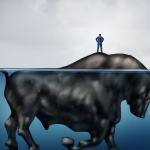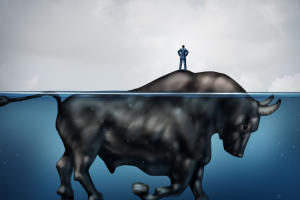
Lessons from an experiment in the 1960s … what would an AGI-based “utopia” do to humans? … why “we’ll all be painters” has flaws …
The biologist had created a perfectly engineered “utopia.”
The focus of the experiment was “what would happen now that the subjects had everything they could ever want? Would it lead to unbridled flourishing?”
It was the opposite.
The experiments, run for decades, always ended the same way…
This idyllic “utopia” devolved into a hellscape of violence, death, and eventually, mass extinction.
Yes, this is a strange way to begin today’s Digest, but stick with me…
In 1968, biologist John Calhoun created what you might think of as a “Garden of Eden” for mice.
It was a pen that held the perfect conditions for rodents – more than enough food and water… a temperate climate… reams of paper and stuffing for the mice to build perfect nests… 256 separated “apartments” for mothers and young … plenty of space to prevent overcrowding due to population growth… and each mouse was pre-screened to eliminate the risk of disease.
It appeared to be an environment perfectly engineered for a burgeoning, healthy population…and yet time and again, it collapsed into a nightmare.
What an increasing number of people are asking today is “Are we on a path toward our own ‘mouse utopia’ thanks to artificial intelligence (AI)?”
Two weeks ago, we began a series that tackles AI from a handful of angles
In our first Digest of the series, we profiled “AGI,” which stands for Artificial General Intelligence.
AGI will exceed human intelligence in every aspect. It’s predicted to be an autonomous agent that can learn without human supervision. It will have some version of consciousness, subjective experience, emotional understanding, and self-reliant decision-making capability.
In that Digest, we looked at the central fear in creating such an AGI: “How do we control a conscious agent that is substantially more intelligent than us?”
Today, let’s look at AI from a different angle. Instead of the potential for AI overlords waging war against humans, let’s assess the risk that AI will have unintended consequences from a sociological perspective.
I’ve read several visions of the future in which AGI is so powerful and efficient that we’ll all eventually stop working and live on a Universal Basic Income (UBI). This will free us to follow our hearts, becoming poets, musicians, sculptors – whatever your dream may be.
In other words, we’ll live in a utopia.
But as Elon Musk said, which we highlighted in our last installment in this series, “with artificial intelligence, we’re summoning the demon.”
Is it possible that the demon we’re summoning is…us?
The hellscape of “mouse utopia”
Calhoun’s most famous “mouse utopia” experiment centered on Universe #25, which began in July 1968.
At first, things seemed wonderful. The eight initial mice bred, and the population doubled every 55 days afterward. It eventually peaked at about 2,200 mice roughly one-and-a-half years into the experiment.
To be clear, this peak population growth wasn’t limited by the size of Calhoun’s physical universe. The pen he created had additional room to support further population growth.
Some studies of mouse utopia argue that overpopulation was the problem, but that’s not the case. From Victor.com:
Despite the abundance of space throughout the enclosure — each compartment could house up to 15 individuals, and the overall enclosure was built for a capacity of 3,000 — most mice were crowding select areas and eating from the same food sources.
No, it wasn’t overpopulation that killed mouse utopic. What led to the decline was something far more sinister…
What happens when “perfection” disrupts traditional social hierarchies and roles
In mouse utopia, mice pups rarely died, grown mice had to do nothing to survive and flourish, and all mice wanted for nothing. This introduced unexpected problems…
Mice have social hierarchies. Dominant alphas control harems of females, and regularly must fight off challengers. In the wild, the losing mouse would scurry off to some distant area and start over. But in mouse utopia, the losing mouse couldn’t escape. And because so many mice were surviving in these idyllic conditions, hordes of these losers – what Calhoun called “dropouts” – would gather in the center of the pens.
Cut, scarred, and angry, these dropouts would occasionally begin brawling for no apparent reason. They would even roam the pen attacking innocent mice. It was just senseless violence. In some of Calhoun’s earlier universes, some of these dropouts turned to cannibalism.
Life wasn’t better for the alphas. With so many mice surviving childhood, the alphas grew tired of defending their harems. So, rogue mice invaded many of the mouse apartments.
The female mice fought back, but this changed their relationship with their existing young, Many of these tired, stressed mothers booted their pups from the nest before the pups were ready. Other mothers abandoned their young. Some even attacked their own offspring.
Then, with all basic needs provided through the experiment, the mice didn’t have to spend their days foraging, creating shelters, or avoiding predators. This lack of broader purpose/responsibility led to new deviant behaviors. Here’s Science History to explain:
Maladjusted females began isolating themselves like hermits in empty apartments—unusual behavior among mice.
Maladjusted males, meanwhile, took to grooming all day—preening and licking themselves hour after hour. Calhoun called them “the beautiful ones.” And yet, even while obsessing over their appearance, these males had zero interest in courting females, zero interest in sex.
Given the violence, lack of traditional roles, lack of sex, and lack of parental support when pups were actually born, the population began to plummet.
Back to Science History:
By the 21st month, newborn pups rarely survived more than a few days. Soon, new births stopped altogether.
Older mice lingered for a while—hiding like hermits or grooming all day—but eventually they died out as well.
By spring 1973, less than five years after the experiment started, the population had crashed from 2,200 to 0. Mouse heaven had gone extinct.
Humans aren’t mice, but…
There are some parallels we’d be foolish to ignore.
First, to address the obvious pushback that mouse behavior is a poor proxy for human behavior, here’s Science Daily:
Studying animals in behavioral experiments has been a cornerstone of psychological research, but whether the observations are relevant for human behavior has been unclear.
Researchers have now identified an alteration to the DNA of a gene that imparts similar anxiety-related behavior in both humans and mice, demonstrating that laboratory animals can be accurately used to study these human behaviors.
And Live Science reports, “Mice are much like humans in how their bodies and minds work. This is why laboratories use mice as test subjects for medicines and other items that may be used on humans. Nearly all modern medicine is tested on mice before they go to human medical trials.”
But whether mouse behavior is representative of human behavior, instinctively, we know that a “perfect society” that requires nothing of us is not healthy.
Humans are hardwired for striving, not leisure. Just about any study on retirement will show you this.
From WebMD:
Even for people who chose to retire, saying goodbye to their career doesn’t always bring happiness… Almost 1 in 3 retirees say they feel depressed – a rate higher than that of the adult population overall.
What we find is that the retirees who are happiest in retirement are the ones who transition from “work” into a different type of “work” – usually, volunteering for something that brings fulfillment along with a continued sense of identity, purpose, and meaning.
A lack of said identity, purpose, and meaning often breeds depression. From New Retirement:
A study published in the Journal of Population Ageing found that those who were retired were about twice as likely to report feeling symptoms of depression than those who were still working.
And research from the London-based Institute of Economic Affairs found that the likelihood that someone will suffer from clinical depression actually goes up by about 40% after retiring.
Then there’s the cognitive decline that accelerates when people stop working, due to the sudden reduction in mental processing. From Forbes:
Research shows a connection between the early stages of retirement and cognitive decline, and numerous studies indicate that retirement can exacerbate a slew of mental health challenges, including anxiety and depression.
As a loose parallel, Calhoun wrote about the “spiritual death” of the mice in his experiment that preceded their physical death…
Here’s Medium:
Calhoun saw the fate of the mouse population as a metaphor for the potential fate of humanity. He called the breakdown of society a “spiritual death,” while physical death was called the “second death” …
Spiritual death, as generally understood, is a disconnection from one’s own essence, values, or beliefs. It can manifest as a loss of purpose, meaning, or sense of belonging…
Are we to believe that an AGI-driven world in which we do nothing but paint, sing, and dance will be meaningful and intellectually stimulating?
I would guess that some of your own times of greatest fulfillment and happiness were found on the other side of a period of intense (and possibly painful) striving, stretching, and battling to accomplish a noble, worthy goal.
Would a lifetime of self-indulgence spent on artistic self-expression really be a utopia? Or might it be fun for a while until the complete absence of responsibility, duty, and self-sacrifice for a goal beyond ourselves turns into a hell of our own making?
The socioeconomic risks of AGI
Let’s return to Medium:
With advances in technology, AI-driven advances could replace almost all mental and/or physical work done by humans within a couple of decades. This could cause major problems in society.
- If it is not distributed fairly, it has the potential to cause the existing imbalance of wealth and power to become an order of magnitude or more severe than it already is. That would lead to authoritarian societies and the potential of despotic dictatorships.
- If fairly distributed, it could grant the population much more free time and they could effectively wither and die, so to speak if they are not imaginative enough to find their own purpose in life or find someone else to give them a purpose in life.
Now, though our focus in this Digest is on the sociological challenges of an AI-driven future, I want to make one comment on the idea of distribution of wealth since the excerpt above tapped into it, and because it relates to sociological risk.
For our entire world to enjoy a UBI, there must be mass redistribution of wealth on a scale we’ve never seen before.
Where is that wealth to come from?
Ostensibly, it will come from the corporations that have benefited from AI, generating all the profits.
Today, these corporations are investing billions of dollars into AI technology. In the coming years, that investment number will climb into the trillions.
Are we to assume that these companies will just hand over their profits to the government for mass redistribution?
What about the risk capital they put on the line? The years of lower earnings due to huge outlays of capital into AI R&D? Is that just ignored?
What about the money you, as an investor, have aligned with that company? What happens to the company’s share price – and your portfolio value – when the government takes those AI profits for redistribution?
I have serious questions about how the corporate world would go along with this, except through an ironfisted government mandate. Of course, that leads us into a discussion about fascism which we’ll sidestep today.
However, on the topic of mass wealth redistribution, a large portion of our citizenry will love the idea and push for it; meanwhile, a significant portion will fiercely resist, viewing it as stealing.
I’m sure nothing could go wrong there…
Keep your eyes open for a deeper dive into AGI from our macro expert Eric Fry
As we noted in the first installment of this series, Eric has turned his attention to AGI in recent months.
He’s creating a series of reports for members of his trading service, The Speculator. If you’re a subscriber, I’m told we’ll get more in the next week or two. We’ll bring you as much as we can here in the Digest.
Now, though in today’s Digest, we’re looking at one darker vision of what AGI might mean for our world, there are also far more optimistic, beautiful ways this could unfold.
And regardless of what’s coming, there will certainly be enormous investment opportunities. As we noted in our first installment, Eric has been zeroing in on ways to play AGI from both “offensive” and “defensive” angles.
Again, keep your eyes open – we’ll be bringing you more on Eric’s investment implications, as well as his specific vision of our AI-driven future.
If the connection I’ve made today between mouse utopia and an AGI-driven world makes you roll your eyes, consider this…
Technology is already radically reshaping our society.
Look at these statistics below and ask yourself – given this age of unprecedented technological advancement, when virtually everything we want is just the touch of a button away – why are these takeaways so horrific?
- Morgan Stanley estimates that by 2030, 45% of women will be single and childless
- According to studies from the University of Michigan and the book “Generations: The Real Differences Between Gen Z, Millennials, Gen X, Boomers and Silents — and What They Mean for America’s Future,” nearly half of teens say they agree with phrases like “I can’t do anything right,” “I do not enjoy life” and “My life is not useful” — roughly twice as many as did just a decade ago
- The CDC reports nearly 3 in 5 teen girls (57%) said they felt “persistently sad or hopeless.” That’s the highest figure in a decade
- Pew Research reports that among men under 30 years old, over 60% are single – that’s almost double the number of women in the same age bracket. A separate study by American Perspectives finds that 15% of men have no close friendships at all, which is a 500% increase since 1990
- Researchers at the University of Indiana report that nearly one in three men between ages 18 and 24 haven’t had sex in the last year. This number has jumped more than 70% since the year 2000
- The Institute for Family Studies reports that the highest number of young adults ever will never marry – 1 in 3.
- In Japan, we now have something called the Hikikomori (Hiki), which in Japanese means “being in solitude.” It refers to children who isolate themselves in their rooms – some for years at this point. The website Steemit reports, “They left the room only for wash (once a month or less), opened the door only for take a food left by their parents, day by day didn’t show any activity, could sit quietly in the room looking at the wall.”
The truth?
We’ve already begun a grand sociological experiment driven by technology and it’s not going particularly well.
And yet, we’re hurtling toward an advanced iteration of AGI that will have consequences far beyond what we can predict.
Will the “birth of AGI” lead to a blissful explosion of creative self-expression, fulfillment, and joy? Or, to borrow from Calhoun and mouse utopia, will it result in the “death of the spirit”?
No one knows.
What we do know is that we’re rolling the dice on a scale never seen before.
Have a good evening,
Jeff Remsburg






